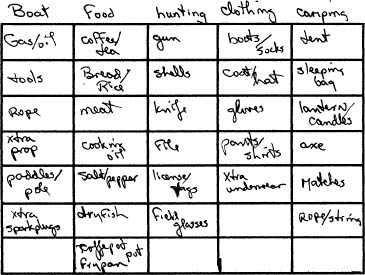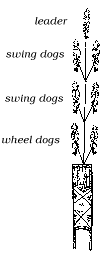Northern Science
Chapter
2
CLASSIFYING
If I go hunting, and pile things into the boat in the exact
order I think of them.
· We will never find the shells when it comes
time to shoot.
· We will have a hard time to find the matches if they are
in the sack with the socks.
My planning is often random. I think of things out of order.
That is why, when I go hunting I try to sort my random thoughts
into separate lists.

Being organized this way helps me remember, and helps me find
things. Being a good scientist requires organized thinking
too.
You could say that I classified the above information according
to the way I planned to use it: boat, food, hunting, clothing,
camping. When I load the boat I try to keep things together that
belong together. I put everything in it's class: tools with tools,
food with food, clothes with clothes etc. As soon as it rains, I
classify them another way. Things that can get wet and those that
cannot. The things that cannot get wet, I have to cover with a
tarp.

|

|
How would you classify your school class. What do the
students have in common?
· Age
· Same town or village
· Same career goals
· Same interests
· Same HS requirement etc.
|
CLASSIFYING IN EVERYDAY
LIFE
Years ago people used to organize their houses (classify the
contents) differently from the way they do now. We made smaller
cabins. We built a cache outside for storage.
In the house we put all things that we used often.
In the cache we put things that we used less often.
There were two main advantages to having this system:
We could build smaller houses that were easier to heat.
If the house burned, we still had supplies in the cache.
You could say that we classified things by how often they were
used. Nowadays our houses are bigger and we can keep more things
in the house.
|

|
When I make a grocery list, I often forget what we need
unless I think:
What do I need for breakfast?
What do I need for lunch?
What do I need for supper?
By classifying groceries by meals I can remember
much better.
|
|

|
When harnessing dogs to a sled, we classify dogs
according to:
intelligence
strength
motivation
If a dog tends to be lazy, we put him closer to the sled.
He is closer to the sled and musher, and more easily
motivated by commands. If he tends to pull too hard early in
the day, we put him in front where he can be more relaxed
and pace himself. If we have a large load and a bad trail,
we put the stronger dogs close to the sled to keep it on the
trail.
Of course, we put the smarter dogs out front and the less
intelligent ones close to the sled so they can't mislead the
team. Mushers move dogs back and forth with these
considerations in mind.
|
Learning to classify is important to developing orderly
thought processes. When our thinking is clear, we can arrive at
clear answers to our problems and situations.
I went hunting with a friend. We split up. When he spotted a
moose, he discovered that he had .270 shells and was carrying a
.30-06. Disorganized thinking was expensive when we desperately
needed meat.
We can develop the ability to look at an object or process many
different creative ways. Matfi found a new way to haul stove oil
with a broken-down snowmachine. Alaskans have always been able to
survive because they could see things in a new way and adapt.
People didn't say, "I need a new part." Instead, they said "I need
something flat and hard." It might be a hacksaw blade, or an inner
part of a cassette player. With a little time and effort we made
it work. Nowadays many people order parts with an 800 number and a
credit card.
How do we classify the parts and contents of our houses now?
Name twenty-five household items. Where would they go in a typical
house in your village or town?
Learning to classify things is important in science too. If you
are going to talk about ducks, will you talk about:
· Size?
· Color/type?
· Taste?
· Habits?
If you are going to have a snowmachine race, you could divide
the races by:
· Size of engine?
· Length of race?
· Age of driver?
· Sex of drivers?
How would you classify the races?
Your teacher has many activities to do with you that will help
you develop clear thinking in this way.
QUESTIONS
1. By putting everything in it's class, we put
_______with tools, ______ with food, and ______ with clothes.
2. Explain how people used to separate their belongings between
the cache and the house.
3. Predict what would happen if the phone company didn't
classify each village or town by the first three numbers. e.g.
574- or 668-.
4. When you go hunting, you take things from the rooms of your
house, bedroom, kitchen and living room where they are classified
according to their purpose. When you put them in the boat, what
new classification are they under now?
5. Argue the case for a messy house. Are there advantages over
a house that is very organized.
Return to the
Table of Contents
or
Go to the
Next Chapter
Write to me at:
AlanDick
Box162
McGrath, Alaska 99627
or fnad@aurora.alaska.edu

